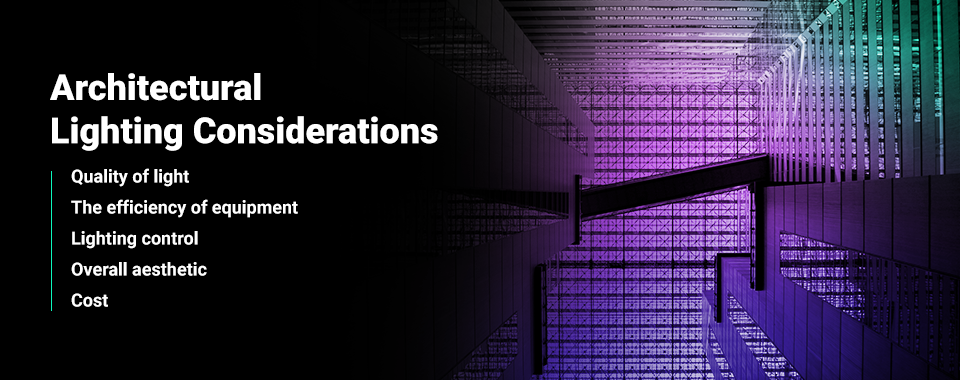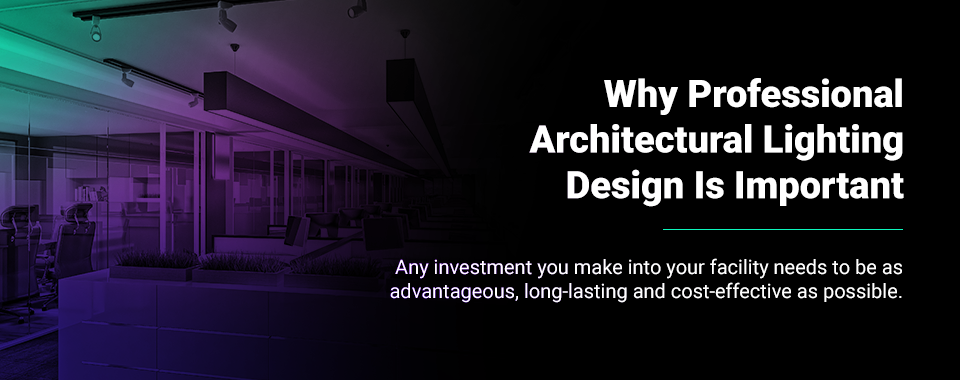How you light your space has a profound impact on those who see it. Interior and exterior lighting systems can accomplish many goals, especially when you integrate architectural lighting effects into the design. That’s why we recommend that building managers implement artificial lighting appropriately and adequately throughout their facilities.
At Illuminated Integration, we understand that architectural lighting systems are an essential component of your interior and exterior lighting systems. Artificial lighting effects can have a dramatic impact on these spaces by enhancing their safety, visibility, security and aesthetic. An efficient, functional and aesthetically-pleasing architectural lighting system can transform your building in dazzling ways.
The Importance of Lighting
Lighting is a necessary element in every space imaginable. While there’s no denying the importance of natural light’s impact on the human body, it’s wise to acknowledge the effect that artificial light has on us as well. We utilize artificial lighting in a variety of ways, relying on it for clear visibility, to help us navigate spaces and to enhance the mood of environments. When integrated creatively, interior and exterior lighting can enhance the architectural features of a building and transform the way visitors experience it.
We perceive our world using a three-step process — we focus on something in our environment, we organize it into something we believe it represents and then we use that representation to interpret what we’re viewing. Using architectural lighting as an example, we may see a dimly lit factory and be reminded of its setting in a horror movie, causing us to perceive it negatively. However, a brightly lit factory that’s showcased with inviting illumination may cause us to view it positively because it looks safe and welcoming.
Light in architecture and psychology of light also applies to light hues. The color of the lights used have a dramatic impact on the way we emotionally perceive a space. Even if we aren’t aware of its influence, we often associate colors with different moods or behaviors. For example, collegiate colors displayed on university buildings can evoke pride, while using the colors of a rival university on your campus may evoke anger. Using colored architectural lighting can also create positive or negative impressions in the viewer.
Architectural Lighting Considerations

What do you think of when you envision architectural lighting? As you envision your completed lighting project, many aspects may either facilitate or complicate your vision. Artificial lighting in architecture requires a specific approach. For exteriors, you need to consider how the weather will impact the lighting. For interiors, you need to make sure that the featured lighting you integrate doesn’t disrupt the primary lighting systems used. Designing the best lighting system for your unique architecture requires you to consider five key elements.
- Quality of light: Not all light sources deliver the same quality of illumination. LED bulbs will provide a different quality of light than halogens, and lower-quality LED lights won’t perform as well as high-quality LED bulbs. You must evaluate the color rendering, light temperature and other aspects of the lighting source so that you can confidently select the type of light source that delivers the quality, clarity and color you desire.
- The efficiency of equipment: The completion of your lighting project is only the beginning. Maintenance is necessary for all machinery, but you should invest in a lighting system that won’t show its signs of age for a long time. This is where efficiency comes in. By choosing bulbs, equipment and fixtures that have high-efficiency, long-lasting features, you’ll have a system that provides reliable, high-quality light for years.
- Lighting control: You need a reasonable degree of control over every system that you install in your facility, including your lighting systems. The latest technologies allow you to manipulate these fixtures and setting in a variety of versatile ways. You can adjust light temperatures, colors and positioning easily. If you’re implementing this system with a desire to modify the lights frequently, you should consider a system that allows you to control each luminaire individually.
- Overall aesthetic: Of course, enhancing your building’s aesthetic is the primary reason for investing in architectural lighting. Be mindful that you need to use lighting temperatures and colors that will complement the areas you’re featuring. This involves taking into consideration the texture of the surface, the color scheme of the area and the appropriateness of the light on the object. You want to illuminate a facade or feature tastefully in a way that doesn’t seem out of place with its surroundings.
- Cost: As with any investment, remember that there’s a difference between “cheap” and “affordable.” You want to invest in an architectural lighting system that will fulfill your needs for years to come. Investing in low-quality equipment or attempting a DIY installation will increase your probability of requiring replacement and repair costs year after year. Choose a lighting team that will deliver reliable equipment and service while sticking within the limits of your budget.
Elements of Architectural Lighting
Architectural lighting sources can be used in the interior and on the exterior of a building. There are three types of general lighting applications — task lighting, ambient lighting and accent lighting. Task lighting is used to increase visibility for performing tasks, ambient lighting is used to fill a space with light and accent lighting is installed to create dramatic architectural lighting effects on the features of the building itself. There are many types of fixtures you can integrate into your space to enhance its features, including:
- Spotlights: Spotlights shine direct, narrow beams of light onto a specific surface. These light sources are easier to control and can be adjusted acutely to ensure your target is in focus. You may see spotlights used to showcase exterior features of a building such as signage, banners or flags. Spotlights can also be used throughout the interior to enhance features like displays, art, sculptures or interior landscaping.
- Floodlights: As the name implies, floodlights are used to flood a large area with even light. Floodlights have a much wider range of coverage than spotlights yet can use the same intensity of light. You may observe floodlights along the exterior of a building near parking lots, entranceways or areas where people may congregate. Floodlights can also be used indoors to add accent lighting or to illuminate areas of darkness that aren’t lit by traditional lighting fixtures.
- Cove: This is a type of uplighting technique that directs light at an interior’s ceiling and walls. Also called ambient luminescence, cove lighting is usually installed in a cove, installed onto or into a wall or integrated into a ceiling coffer. Cove lighting provides diffused, even light to create a reflection off of high walls or ceilings. Cove lighting can be used as both accent and primary lighting. One benefit of this light source is that the fixtures are hidden from view.
- Soffit: Similar to cove lighting, soffit lighting is also hidden and produces ambient lighting. This type of lighting can be direct or indirect, focusing on enhancing the aesthetic of the architecture it illuminates or providing visibility for those walking through the area. These light sources may be installed below exterior overhangs or roofs as well as indoors above cabinetry, partitions or other interior structures below the ceiling. Also known as cornices, soffit lighting fixtures can produce dramatic architecture lighting effects by focusing on textured surfaces.
- Valance: Valance lighting can direct light both upward and downward, utilizing both simultaneously or separately as needed. This type of lighting source is often adjusted to specific heights based on the limitations and uses of the space. For example, it may be installed at a lower height if it’s used for task lighting or installed at a higher position along the length of a wall if it’s meant for enhanced visibility or accent lighting.
Benefits of Architectural Lighting

Consider the many reasons why you may install lighting systems throughout the interiors of your buildings. These lights can increase the visibility and safety of an area for your employees and guests. Lighting also impacts the aesthetic of a space and influences the moods of those in it. The importance of lighting in building interiors applies to the exterior as well. The benefits of architectural lighting can work with natural light and other electrical lighting to transform your space.
- Enhanced aesthetic: Whereas task lighting is limited to its sole function, architectural lighting is inherently collaborative and complementary. The lighting interacts with the features of the architecture in ways that other types of lighting cannot. As the light interacts with textures, colors and spatial borders, it can enhance these features in both direct and subtle ways. By enhancing the aesthetic of the architecture, light can change the way people react to and experience a space.
- Increased visibility: Of course, the primary function of any light source is to illuminate a space so that it is adequately visible. Have you stopped to consider how vital the visibility of your building is? Visibility via artificial lighting in architecture can help your clients and customers locate your building. Showcasing your facade and grounds can help reflect the pride you have in the quality of your products, services and employees. Increased visibility could also help bring new visitors and business to your establishment.
- Increased safety: Improving visibility with adequate lighting in both interior and exterior spaces can enhance safety in various ways. While too much of the wrong type of lighting source may be intrusive, integrating an appropriate amount of light will make the area more visible. Even architectural accent lighting can add an extra element of visibility that helps individuals navigate and work in a space with a higher level of safety.
- Increased security: Security is a major component of safety. When you increase the visibility of a space adequately, you can potentially deter others from trespassing. This includes unintentional trespassing, as it’s easy for visitors, customers or even employees to venture into a private space if they’re unfamiliar with an area. During hours in which there are limited people in the building, architectural lightings like valences or track lighting can be set with motion sensors to alert security if others are in the area.
Why Professional Architectural Lighting Design Is Important

Any investment you make into your facility needs to be as advantageous, long-lasting and cost-effective as possible. By enlisting the help of professional architectural lighting designers, you’re safeguarding your investment with the help of industry experts. These individuals have years of experience designing and implementing architectural lighting systems in a diverse range of contexts. Their knowledge of the latest technology and newest lighting techniques ensures that your system boasts the reliable versatility you need. Most importantly, professionals will keep your budget controlled from installation through long-term system management.
There’s a reason why building managers operating facilities of all shapes and sizes trust Illuminated Integration for all of their AVL needs. We prioritize the safety and security of your property, and we understand that light in architecture and psychology of light plays a vital role in presenting your building to clients, consumers and employees. Our goal is to not only meet your needs but to help you design a versatile architectural lighting system that will benefit you and your budget for the long-term.
Each of our architectural lighting designs is built from the ground up and customized to your exact specifications. Your team will be involved in every aspect of the process, from the initial design to the final stages of installation. Using the latest technology, we’ll outfit your space using cutting-edge techniques that produce dynamic architectural lighting effects. Once we’ve completed the implementation process, our team will continue to be available to provide guidance and support for years to come.
Architectural Lighting Systems From Illuminated Integration

Understanding light in architecture and psychology of light can help you create a space that feels safe, secure, welcoming and appealing. While natural lighting may meet these demands in the daytime, artificial lighting in architecture during the evening and night hours is a necessity for any building owner who wants to protect their brand, their employees and their visitors.
Your facility should be showcased beautifully inside and out. Let the AVL experts at Illuminated Integration help you achieve the architectural lighting effects needed to project a sense of pride. Our team is ready to make your vision a stunning reality. Contact us today to learn more about our architectural lighting design possibilities.





